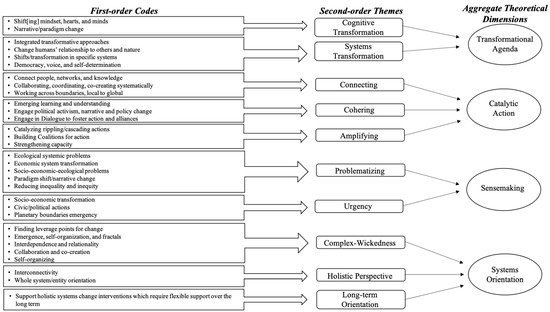Transformation catalysts (TCs) are ways of organizing that take catalytic actions to connect, cohere, and amplify the efforts of numerous initiatives oriented towards resolving complex socio-ecological problems like the ones embedded in the UN's Sustainable Development Goals. TCs target systems-level solutions by working with narrative to bring about cognitive or paradigm shifts and orient towards systemic change. They take catalytic actions by connecting, cohering, and amplifying the actions of numerous otherwise unconnected actors. TCs use sensemaking processes to problematize and create urgency around key issues, through adopting a systems orientation.
- transformation catalyst
- catalytic action
- system transformation
- SDGs
- connecting
- cohering
- amplifying
- sensemaking
1. Introduction
2. Defining Transformation Catalysts
“Transformations catalysts (TCs) are promising organizing innovations specifically designed to address complexly wicked societal problems and opportunities and bring about purposeful system transformation. … Specifically, they connect, cohere, and amplify efforts of other initiatives in an attempt to overcome the fragmentation and lack of impact …. They help coalitions of actors emerge shared visions, goals, aspirations, or other narratives that enable them to align their efforts, even while they pursue their individual agendas”.[1] (p. 168)
3. Identifying What Transformation Catalysts Do

| Overarching Action | Defined as | Evidenced by | |||||||||||
|---|---|---|---|---|---|---|---|---|---|---|---|---|---|
| The ‘What’ and ‘Where’: systems transformation agenda: | Systems transformation involves targeting systems-level (or whole-system) solutions to bring about large-scale and fundamental changes in the relevant system(s) versus more incremental or fragmented approaches | Cognitive transformation | : bringing about shifts in peoples’ mindsets, mental models, and paradigms by reconfiguring and transforming what are known as cultural narratives and telling inspiring new stories |
| Systems transformation | : targeting systems-level (or whole-system) solutions to bring about large-scale and fundamental changes in the relevant system(s) versus more incremental or fragmented approaches |
| ||||||
| The ‘Who’ and ‘How’: catalytic actions | Catalytic actions involve connecting, cohering, and amplifying the work of partners and collaborators, defined as bringing together a network of change-makers and supporting collaboration across, disciplines, sectors, nations, and other boundaries to co-create and emerge transformative change and build sustainable futures for all | Connecting | : connecting initiatives/people together to inspire them to collaborate, coordinate, and co-create systemic action in the desired direction. |
| Cohering | : building strong alliances and collaborative relationships across silos by combining, unifying, and synthesizing knowledge and strategies that build capacity to act and finance transformative change |
| Amplifying | : strengthening and empowering diverse groups of actors to organize, mobilize, and take action to create transformative change that impacts at different levels (community to regional to national and global) |
| |||
| The ‘Why’ and ‘When’: sensemaking | Sensemaking involves TCs clearly acknowledging why and when transformative change is needed in a broad variety of contexts, recognizing issues and their impacts, and articulating/disseminating the urgent need for transformative change and how it will be done, including shifting narratives. | Problematizing specific topics | : articulating the problems in today’s systems and the sometimes existential challenges to humanity that they represent, and arguing for a paradigm or systemic transformation towards flourishing futures |
| |||||||||
| Urgency for transformation | : acknowledge that addressing the problems raised (in problematizing) requires urgent systems-level transformation at speed and scale that can only be achieved through targeted actions and mobilizations |
| |||||||||||
| The ‘approach’: systems orientation | Adopting a systems orientation (systems thinking), which means thinking in terms of complex adaptive systems and wicked problems (with or without that specific language) and taking a holistic perspective on systemic change | Systems orientation | : adopting a systems understanding (systems thinking), which means thinking in terms of complex adaptive systems and wicked problems (with or without that specific language) and taking a holistic perspective on systemic change | ||||||||||
| Complex wickedness (wicked complexity) |
| ||||||||||||
| Holistic perspective | : recognizing that everything in complex wickedness is interconnected, spans multiple levels and sectors, and therefore need to be tackled holistically rather than in silos because the systems of interest can be considered living systems |
| |||||||||||
| Long-term orientation | : seeing things and the prospects of systems over the long term, seeking long-lasting solutions and changes in systems to achieve long-term environmental and social sustainability for the future |
4. Concluding remarks
Transformation catalysts represent an emerging way of organizing change agents and initiatives that we argue are needed to integrate transformation initiatives, so that they can more effectively address the complexity, interconnectedness, and wickedness of achieving transformational goals, such as the SDGs and other such efforts.
An understanding of what TCs are and how they operate is timely and important because wickedly complex challenges associated with the UN SDGs require transformational change, not incremental or piecemeal approaches. Such transformational changes cannot be achieved by any single entity alone, be it government agencies, businesses, or NGOs. What is needed is the collective and coherent action of many initiatives guided by common aspirations. We believe that TCs may be a ray of hope in this context of complexly wicked problems. Moreover, by analyzing how the entities identified as TCs actually undertake their work and identify commonalities across such entities, this study provides those interested in system transformations with an understanding of what elements are needed if TCs are to work, and how new ones can emerge.
References
- Waddock, S.; Waddell, S. Transformation Catalysts: Weaving Transformational Change for a Flourishing World for All. Cadmus 2021, 4, 165–182.
- Levin, K.; Cashore, B.; Bernstein, S.; Auld, G. Overcoming the Tragedy of Super Wicked Problems: Constraining Our Future Selves to Ameliorate Global Climate Change. Policy Sci. 2012, 45, 123–152.
- Ackoff, R.L. Redesigning the Future: A Systems Approach to Societal Problems; John Wiley & Sons: New York, NY, USA, 1974; ISBN 978-0-471-00296-3.
